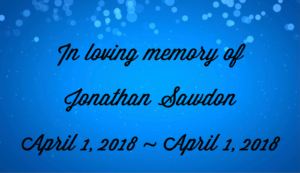Loss

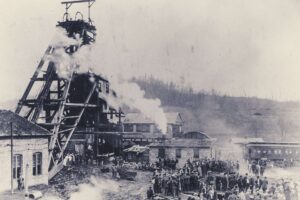 If you lived in Eccles, West Virginia in 1914, you or someone in your family most likely worked at the Eccles Mine Number 5. Eccles was a tiny town in Raleigh County. Mine number 5 was opened in 1905, and by 1914, the mine employed most of the local men and even the teenagers. Life was mundane for the most part. Not much happened in the town, and April 28, 1914 promised to be just another boring day. On that Tuesday morning, dozens of local men and teens left their homes to go to work at the Eccles Mine Number 5, which was one of group of coal mines in West Virginia owned by the New River Colliers Company. Everything was going along fine, when suddenly, at 2:30pm, a sudden explosion rocked the Number 5 mine. In an instant, more than 180 workers who had left home as usual that day, would never go home again.
If you lived in Eccles, West Virginia in 1914, you or someone in your family most likely worked at the Eccles Mine Number 5. Eccles was a tiny town in Raleigh County. Mine number 5 was opened in 1905, and by 1914, the mine employed most of the local men and even the teenagers. Life was mundane for the most part. Not much happened in the town, and April 28, 1914 promised to be just another boring day. On that Tuesday morning, dozens of local men and teens left their homes to go to work at the Eccles Mine Number 5, which was one of group of coal mines in West Virginia owned by the New River Colliers Company. Everything was going along fine, when suddenly, at 2:30pm, a sudden explosion rocked the Number 5 mine. In an instant, more than 180 workers who had left home as usual that day, would never go home again.
The explosion was caused by coal-seam methane. At least 180 men lay dead, at least that was the death roll published as of 2011 by the National Coal Heritage Trail. A monument at the cemetery lists 183 victims, and  the records of the county coroner list 186. When the mine was rocked by a series of violent explosions, parts of the mine collapsed while other parts were heavily damaged, which trapped the miners inside. Of course, the people of Eccles and officials from the mining company rushed to the scene to aid the rescue efforts. Despite their best efforts, it was soon obvious that this would be a recovery effort, and not a rescue. That day, all of the miners in Eccles Mine Number 5 were killed, including five who were under the age of 14 years of age. In addition, nine workers in a nearby mine were killed when deadly gas from Mine Number 5 seeped into their mine. Ironically, one of the men who died in the nearby mine, was an insurance agent from Charleston, West Virginia, who had only gone into the mine to solicit business from the men. He was only there for a few minutes. It was there that the salesman, who had unfortunately chosen that day to visit the mine and sell insurance to its workers, was also killed. The blast and the subsequent damage to the mine, left many of the victim so mangled and torn apart, that most of them could not be positively identified because of their horrific injuries.
the records of the county coroner list 186. When the mine was rocked by a series of violent explosions, parts of the mine collapsed while other parts were heavily damaged, which trapped the miners inside. Of course, the people of Eccles and officials from the mining company rushed to the scene to aid the rescue efforts. Despite their best efforts, it was soon obvious that this would be a recovery effort, and not a rescue. That day, all of the miners in Eccles Mine Number 5 were killed, including five who were under the age of 14 years of age. In addition, nine workers in a nearby mine were killed when deadly gas from Mine Number 5 seeped into their mine. Ironically, one of the men who died in the nearby mine, was an insurance agent from Charleston, West Virginia, who had only gone into the mine to solicit business from the men. He was only there for a few minutes. It was there that the salesman, who had unfortunately chosen that day to visit the mine and sell insurance to its workers, was also killed. The blast and the subsequent damage to the mine, left many of the victim so mangled and torn apart, that most of them could not be positively identified because of their horrific injuries.
In the early 1900s, coal was in great demand. Production in the United States had increased from 50 million tons of coal in 1850 to 250 million tons of coal in 1903. Unfortunately, the increasing demand and the rush to supply, brought with it worsening work conditions. The danger occurred when the men were digging for coal in deep mines, in which chambers of gas lay just underneath. That meant that highly explosive gasses could come into contact with carbide headlamps. The next thing they knew, they had an explosion on their hands. The mine 
 disaster brought attention to an overall safety problem in the West Virginia mining industry. Sadly…at least in that it didn’t happen sooner, the disaster actually aided the unions’ attempts to improve the workers’ conditions. The labor union helped to ban carbide headlamps in West Virginia. It was suspected that the headlamps were most likely the cause of the Eccles explosion, as well as a second mine explosion 18 years later in Illinois.
disaster brought attention to an overall safety problem in the West Virginia mining industry. Sadly…at least in that it didn’t happen sooner, the disaster actually aided the unions’ attempts to improve the workers’ conditions. The labor union helped to ban carbide headlamps in West Virginia. It was suspected that the headlamps were most likely the cause of the Eccles explosion, as well as a second mine explosion 18 years later in Illinois.
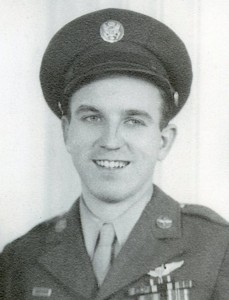
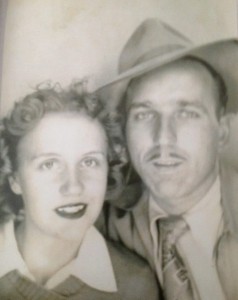 I have been studying a lot lately about World War II. It is my “favorite” war…if one can have a favorite war. My dad, Allen Spencer was a Staff Sergeant in World War II. He served as flight engineer and top turret gunner on a B-17G, the flying fortress. The more I study World War II, the more I realize just how dangerous was…no matter what branch of the service a soldier was in. Dad’s family was one that didn’t have to suffer the loss of their soldier, because my dad came home after the war. He was the only one in his family that saw action in World War II, other than his half-brother, Norman Spencer. Dad’s older brother, Bill tried to serve, but due to flat feet and a hernia, he was turned down. My Uncle Bill was devastated by the rejection. My dad was his little brother, and he had always felt a need to protect him, not because Dad was accident prone or anything, but because he was his little brother. Now, he was going to have to let Dad go without the “backup” that Uncle Bill had hoped to provide. That was one of the hardest things my Uncle Bill ever had to do. So, Dad went with angel backup instead…and his mother’s prayers.
I have been studying a lot lately about World War II. It is my “favorite” war…if one can have a favorite war. My dad, Allen Spencer was a Staff Sergeant in World War II. He served as flight engineer and top turret gunner on a B-17G, the flying fortress. The more I study World War II, the more I realize just how dangerous was…no matter what branch of the service a soldier was in. Dad’s family was one that didn’t have to suffer the loss of their soldier, because my dad came home after the war. He was the only one in his family that saw action in World War II, other than his half-brother, Norman Spencer. Dad’s older brother, Bill tried to serve, but due to flat feet and a hernia, he was turned down. My Uncle Bill was devastated by the rejection. My dad was his little brother, and he had always felt a need to protect him, not because Dad was accident prone or anything, but because he was his little brother. Now, he was going to have to let Dad go without the “backup” that Uncle Bill had hoped to provide. That was one of the hardest things my Uncle Bill ever had to do. So, Dad went with angel backup instead…and his mother’s prayers.
Dad served and returned home to his family, and because he did, my sisters and I, and our whole family exists. 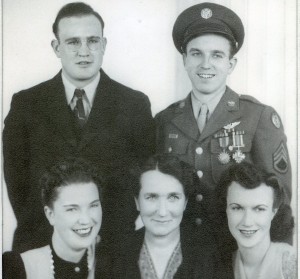
 Dad, like many of the soldiers in that generation, never spoke of his time in the service during World War II, and all we knew was what little we heard from his family, and a couple of newspaper articles. Knowing my dad as we did, those years were his duty, but never his desire. Dad was a gentle man, and the idea of killing must have weighed heavily on him. Nevertheless, he knew it was his duty, and he would never have shirked his duty. There were a number of heroic times in Dad’s time in the service. He actually saved his crew, when he cranked down the landing gear just in time to hit the runway. It must have been damaged by the anti-aircraft flak, because it wouldn’t come down. There were other times that his actions saved his crew, such as the enemy planes that he shot down. They were a good team. They were all heroes…every single one.
Dad, like many of the soldiers in that generation, never spoke of his time in the service during World War II, and all we knew was what little we heard from his family, and a couple of newspaper articles. Knowing my dad as we did, those years were his duty, but never his desire. Dad was a gentle man, and the idea of killing must have weighed heavily on him. Nevertheless, he knew it was his duty, and he would never have shirked his duty. There were a number of heroic times in Dad’s time in the service. He actually saved his crew, when he cranked down the landing gear just in time to hit the runway. It must have been damaged by the anti-aircraft flak, because it wouldn’t come down. There were other times that his actions saved his crew, such as the enemy planes that he shot down. They were a good team. They were all heroes…every single one.
While my dad was a hero during World War II, I will always consider his most important accomplishment, his family. Without my dad’s safe return from the war, we would not exist. He met my mom, Collene Byer Spencer when she was still a schoolgirl, but even then, they knew it was that forever love. They married in 1953, an 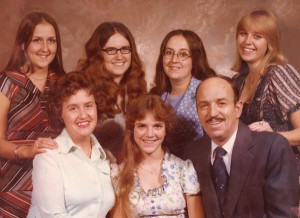
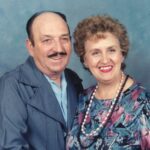 became the parents of five daughters, Cheryl, Masterson, Caryn Schulenberg (me), Caryl Reed, Alena Stevens, and Allyn Hadlock. They went on to have grandchildren and great grandchildren…all of whom owe their lives to the fact that dad came home from war. For that I praise God, and I give Him all the glory. Today would have been my dad’s 99th birthday. Happy birthday in Heaven, Dad. We love and miss you very much and look forward to seeing you again when we get to Heaven.
became the parents of five daughters, Cheryl, Masterson, Caryn Schulenberg (me), Caryl Reed, Alena Stevens, and Allyn Hadlock. They went on to have grandchildren and great grandchildren…all of whom owe their lives to the fact that dad came home from war. For that I praise God, and I give Him all the glory. Today would have been my dad’s 99th birthday. Happy birthday in Heaven, Dad. We love and miss you very much and look forward to seeing you again when we get to Heaven.

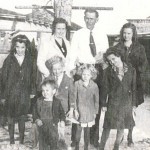 My aunt, Deloris “Dee” Johnson was such a sweet person. She was the third child of my grandparents, George and Hattie Byer, and she truly loved her little siblings. She was happy to teach them things, and when she could, she really enjoyed buying things for them. One of the biggest gifts was a piano that graced Grandma Byer’s house for the rest of her life. We all played on that piano, and sometimes I wonder how Grandma kept her sanity. Nevertheless, that piano was a great blessing, and it was Aunt Dee’s great pleasure to gift it to her family. Aunt Dee was really a very special sister to her siblings.
My aunt, Deloris “Dee” Johnson was such a sweet person. She was the third child of my grandparents, George and Hattie Byer, and she truly loved her little siblings. She was happy to teach them things, and when she could, she really enjoyed buying things for them. One of the biggest gifts was a piano that graced Grandma Byer’s house for the rest of her life. We all played on that piano, and sometimes I wonder how Grandma kept her sanity. Nevertheless, that piano was a great blessing, and it was Aunt Dee’s great pleasure to gift it to her family. Aunt Dee was really a very special sister to her siblings.
Aunt Dee had a big imagination. She wanted to see how it felt to be a bird, so she gathered up one of her younger siblings, wrapped up in a trench coat, and stood in the wind. Of course, they didn’t really fly, but it felt like it. I know, because I’ve done that myself. It’s lots of fun. My mom, Collene Spencer, Aunt Dee’s younger sister said that her sister was always inventing something, but Mom didn’t tell me what. I’m sure that over the years everyone forgot what they were, because if they weren’t successful, that would be the end of it. Her son, Elmer did say that his mom was the true inventor of the “shoe watch.” That was an invention she started by attaching a watch to her shoe to help her be on time. It didn’t help Aunt Dee, but then being on time was something that the Byer family was famous for not being.
Aunt Dee grew up in a household of singing. Grandma Byer made housework fun for her nine children with the 
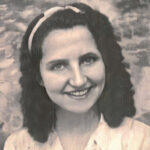 “sing while you work” concept. Aunt Dee, like most of her siblings carried that into her adult life. I think they all thought that singing gave them a sunny disposition, and I would have to agree. Having a mom who sings around the house, makes for a lighthearted home. I think that as a child of a song-filled home, my cousins would agree that a singing mom is one of the more pleasant memories of our childhood. Today would have been my Aunt Dee’s 92nd birthday. She has been in Heaven now for 27 years. I find that so hard to believe. Happy birthday in Heaven, Aunt Dee. We love you and still miss you very much.
“sing while you work” concept. Aunt Dee, like most of her siblings carried that into her adult life. I think they all thought that singing gave them a sunny disposition, and I would have to agree. Having a mom who sings around the house, makes for a lighthearted home. I think that as a child of a song-filled home, my cousins would agree that a singing mom is one of the more pleasant memories of our childhood. Today would have been my Aunt Dee’s 92nd birthday. She has been in Heaven now for 27 years. I find that so hard to believe. Happy birthday in Heaven, Aunt Dee. We love you and still miss you very much.
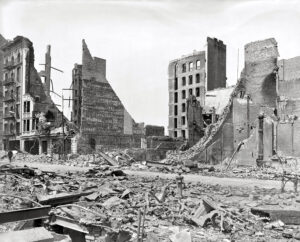 On April 18, 1906, many of the people in the San Francisco, California area were sound asleep in their beds. It was, after all, 5:13am. Suddenly, the people were jolted awake by an earthquake, which was estimated to be close to 8.0 on the Richter scale. When the quake struck San Francisco, California, it toppled numerous buildings. The cause of the quake was a slip of the San Andreas Fault over a segment about 275 miles long. The resulting shock waves could be felt from southern Oregon down to Los Angeles.
On April 18, 1906, many of the people in the San Francisco, California area were sound asleep in their beds. It was, after all, 5:13am. Suddenly, the people were jolted awake by an earthquake, which was estimated to be close to 8.0 on the Richter scale. When the quake struck San Francisco, California, it toppled numerous buildings. The cause of the quake was a slip of the San Andreas Fault over a segment about 275 miles long. The resulting shock waves could be felt from southern Oregon down to Los Angeles.
At that time, San Francisco’s had a variety of brick buildings and wooden Victorian structures that were not really earthquake reinforced. Nobody knew about making buildings strong enough to resist destruction from an earthquake. It was one of the things we would learn from the results of a disaster. It seems that with each disaster, we learn how to prevent the loss of so many buildings and lives. The old buildings were devastated. Along with the collapsed buildings, came devastating fires, and because many of the water mains had broken, firefighters were prevented from stopping 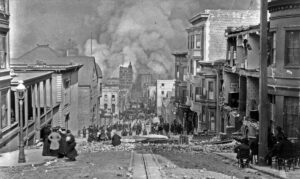 the fires. Firestorms soon developed citywide. US Army troops from Fort Mason reported to the Hall of Justice around 7am, and San Francisco Mayor E.E. Schmitz set a dusk-to-dawn curfew and authorized soldiers to shoot to kill anyone found looting. Disasters like these always seem to bring out the worst in people, even those who might not have done such things under normal circumstances.
the fires. Firestorms soon developed citywide. US Army troops from Fort Mason reported to the Hall of Justice around 7am, and San Francisco Mayor E.E. Schmitz set a dusk-to-dawn curfew and authorized soldiers to shoot to kill anyone found looting. Disasters like these always seem to bring out the worst in people, even those who might not have done such things under normal circumstances.
As significant aftershocks continued, firefighters and US troops fought desperately to control the ongoing fires. Sadly, that sometimes meant dynamiting whole city blocks to create firewalls. Many people were trapped where they were, because the fires prevented their escape, even though they were not stuck in a collapsed building. Finally, on April 20th, several thousands of refugees were evacuated from the foot of Van Ness Avenue. The army would eventually house 20,000 refugees in more than 20 military-style tent camps across the city. The people had no idea how long they might have to be there.

Most of the fires were extinguished by April 23rd, and the authorities started the task of rebuilding the devastated city. In all, approximately 3,000 people lost their lives as a result of the Great San Francisco Earthquake and the devastating fires it inflicted upon the city. Almost 30,000 buildings were destroyed, including most of the city’s homes and nearly all the central business district. The rebuilding would take a long time, and the new structures were reinforced to be able to better withstand the shaking of the San Andreas fault. This quake may not have been the “Big One” that is predicted, but at an estimated 7.9 or 8.0, it was right up there.
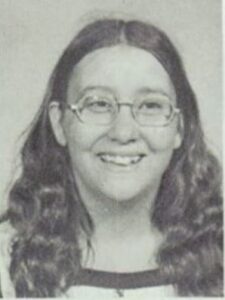
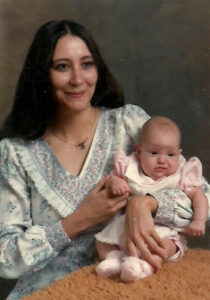 My cousin, Darla Stanko passed away on February 26, 2023, at 63 just years old. As I think of Darla, I remember her laugh, which was just like her mother’s. It was sweet and a little shy, but when they laughed…you laughed, because their laugh was contagious. As kids, we would all go down in Grandma Byer’s basement to play, while the grownups visited upstairs. Grandma’s basement was a little creepy and worked well as a “haunted” house…if the kids liked that sort of thing. Some did and some didn’t. I preferred other games. I think Darla did too. She had asthma and scary stuff could trigger things.
My cousin, Darla Stanko passed away on February 26, 2023, at 63 just years old. As I think of Darla, I remember her laugh, which was just like her mother’s. It was sweet and a little shy, but when they laughed…you laughed, because their laugh was contagious. As kids, we would all go down in Grandma Byer’s basement to play, while the grownups visited upstairs. Grandma’s basement was a little creepy and worked well as a “haunted” house…if the kids liked that sort of thing. Some did and some didn’t. I preferred other games. I think Darla did too. She had asthma and scary stuff could trigger things.
As kids do, we all grew up…quicker than we would ever have dreamed possible. Before long, babies were coming along. I remember talking to Darla once. She told me that without a doubt, the best thing she ever did was JeanAnn, and of that I have no doubt. For a mom to look at the beautiful little baby they have just given birth to…there is no greater honor. Kids are a big part of our lives, and games are a part of kids. JeanAnn told me about the times she and her mom played cards. Their favorite game was Speed…which is a high drama card matching game for two players. It was perfect for them.
The other thing that JeanAnn and her mom loved to do was to spend time jumping on the trampoline in their yard. I can just picture it now, a summer evening in the back yard, just the two girls, jumping and giggling the hours away. Of course, there was also their dog, Nelly with them too. Now Nelly was a different sort of dog. She was very gentle with JeanAnn, but then she was JeanAnn’s guard dog. She was also gentle with Darla too…except for that one time. JeanAnn could make Nelly mad and then point at a new person, and Nelly would go get that person. That was all well and good…until JeanAnn did that to her mom. My guess is that JeanAnn had no idea what was about to take place. Darla saw it coming, and she jumped on the furniture to get away from the guard dog that was now hot on her trail. She almost knocked herself out jumping down. JeanAnn 
 says, “It was great” and maybe it was…for her anyway. Darla…maybe not so much, but I’m sure she laughed about it later.
says, “It was great” and maybe it was…for her anyway. Darla…maybe not so much, but I’m sure she laughed about it later.
Now, for me, possibly the funniest story about Darla’s life was the “fateful” trip to Denver. Darla decided to take her daughter to Denver, and to take her mom, my Aunt Delores Johnson with them. She needed a “navigator” and while I can’t picture my Aunt Dee in that capacity, maybe Darla thought map reading was like breathing…anyone could do it. My thought is, “Have you met your mother?” Anyway, off they went, and to make a long story short, they ended up on a one street in rush hour traffic, going the wrong way!!” Oh yes, that’s the Aunt Dee I know, and I can totally picture that whole situation…once I can stop laughing!!

 My sister-in-law, Rachel Schulenberg joined our family when she married my brother-in-law, Ron Schulenberg on June 2, 2010. It was a match made in Heaven. Rachel was introduced to Ron by his nieces, Machelle Moore and Susan Griffith. She was perfect for Ron. She was kindhearted and sweet, and a blessing to all who knew her. Rachel was a Christian girl, who worked at a church in Powell, Wyoming, when she was introduced to Ron. She was dedicated to the Lord, and witnessed to everyone she came across.
My sister-in-law, Rachel Schulenberg joined our family when she married my brother-in-law, Ron Schulenberg on June 2, 2010. It was a match made in Heaven. Rachel was introduced to Ron by his nieces, Machelle Moore and Susan Griffith. She was perfect for Ron. She was kindhearted and sweet, and a blessing to all who knew her. Rachel was a Christian girl, who worked at a church in Powell, Wyoming, when she was introduced to Ron. She was dedicated to the Lord, and witnessed to everyone she came across.
Rachel was a wonderful mom to her kids, Cassie Franklin, Riley Birky, and Tucker Schulenberg. She is also an amazing grandmother to her grandchildren, Lucas and Zoey Iverson. I just wish she had known her grandkids, Ryder Birky and Alicen Burr, as well as bonus baby, Jace. She would have absolutely loved these new little ones. Rachel really was a great mom and grandma. It really blessed her heart to become a grandma. I think that quite often, when we are done having kids, we almost immediately start to look forward to having grandkids. After all, it’s all about the babies. Who doesn’t love babies? No one, I know anyway!! 

Rachel was a part of our family for the last ten years of her life. Like her mother, Connie who died in 1985, when she was 35 years, Rachel passed away at a young age. Rachel was just 45 years old when she passed away. It is always so sad when someone so young leaves us so early. Rachel died of a stroke, which is, I believe, how her mother also passed away. Looking back, so many of us wish she was still with us today. Rachel had such a sweet way about her. Kindness radiated from her, because she was kind deep down in her heart. How can someone so young, leaves us so soon? When Rachel left us, she left a huge hole in the hearts of everyone who cared about her…and believe me, that was a lot of people.
Rachel changed everything in Ron’s life, and in the life of her kids and grandkids. My only wish is that their time w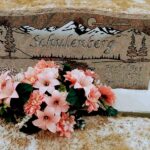
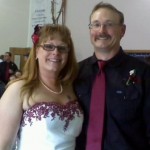 ith her hadn’t been so short. They all really needed her in their lives for many more years. Rachel’s influence in their lives was beyond huge. Everyone needs the influence of their mother and grandmother, but sadly, when they are gone, you really find out how badly you missed them. There are countless number of times that all you want to do is pick up that phone to ask them a question or tell them about your day. Today would have been Rachel’s 48th birthday. Happy birthday in Heaven, Rachel. We love and miss you very much, and can’t wait to see you in Heaven, when we all get there.
ith her hadn’t been so short. They all really needed her in their lives for many more years. Rachel’s influence in their lives was beyond huge. Everyone needs the influence of their mother and grandmother, but sadly, when they are gone, you really find out how badly you missed them. There are countless number of times that all you want to do is pick up that phone to ask them a question or tell them about your day. Today would have been Rachel’s 48th birthday. Happy birthday in Heaven, Rachel. We love and miss you very much, and can’t wait to see you in Heaven, when we all get there.

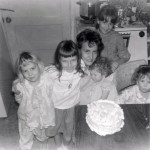 My mom, Collene Spencer went home to be with the Lord, eight years ago today. It’s so hard for me to believe she has been gone that long. That was the day my sisters and I officially became adult orphans. It’s a strange thing to think about, after having your parents with you most of your life. I think that the things I miss most about my mom are her faith in God, her natural goodness, and her humor. Mom’s humor still makes me laugh today. She really was kind of a natural comedienne. She loved to laugh, and even more than that, she loved to make others laugh. She was known for the funny faces she made, and the goofy things she would do.
My mom, Collene Spencer went home to be with the Lord, eight years ago today. It’s so hard for me to believe she has been gone that long. That was the day my sisters and I officially became adult orphans. It’s a strange thing to think about, after having your parents with you most of your life. I think that the things I miss most about my mom are her faith in God, her natural goodness, and her humor. Mom’s humor still makes me laugh today. She really was kind of a natural comedienne. She loved to laugh, and even more than that, she loved to make others laugh. She was known for the funny faces she made, and the goofy things she would do.
Mom was the true middle sister. She had three older sisters, Evelyn Hushman, Virginia Beadle, Dolores Johnson, followed by brother Larry Byer. She also had a younger brother, Wayne Byer, followed by three sisters, Bonnie McDaniels, Dixie Richards, and Sandy Pattan. I think her humorous side might have come from her brothers, both of whom were hilariously funny. I could say they were a bad influence on her, but even with their mischievous personalities, they were really a good influence on her. The three of them were always in some sort of “trouble” with their mom. Not real trouble, just mischief. There was never a dull moment. That’s how it was when Mom got her girls laughing too. Never a dull moment.
My mom loved to sing, and she made sure that our days started off with something like “Keep on the Sunny Side” or “You Are My Sunshine.” Even if we didn’t “feel” sunny, she tried to bring out the sunshine in a cloudy day. We didn’t really know just what a wise woman our mother was, but looking back, I wish we had known. Starting your day with a smile is probably the single best way to start your day. Life isn’t always easy, but living life with a smile on your face gives it joy. All too often, we try to be far too serious, and we miss out on all the 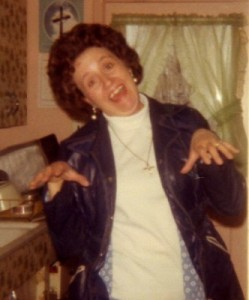
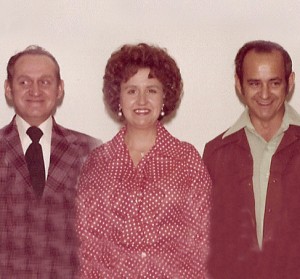 funny parts of life. Mom didn’t hold grudges. She just wouldn’t allow those kinds of feeling to ruin her day or her life. She tried to teach that to us too, and I like to think she succeeded. We may not jump out of bed with a smile on our faces…at least not before a few cups of coffee, but we are all happy people, and on occasion, we still sing those songs, because it reminds us of our sweet mom. It’s really hard for me to believe that Mom has been gone for eight years now, but it is really easy to believe that she is in Heaven, because it was Jesus in her heart that made her so happy. We love and miss you everyday Mom, and we can’t wait to see you again.
funny parts of life. Mom didn’t hold grudges. She just wouldn’t allow those kinds of feeling to ruin her day or her life. She tried to teach that to us too, and I like to think she succeeded. We may not jump out of bed with a smile on our faces…at least not before a few cups of coffee, but we are all happy people, and on occasion, we still sing those songs, because it reminds us of our sweet mom. It’s really hard for me to believe that Mom has been gone for eight years now, but it is really easy to believe that she is in Heaven, because it was Jesus in her heart that made her so happy. We love and miss you everyday Mom, and we can’t wait to see you again.

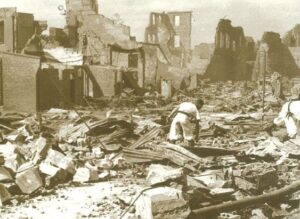 February 3, 1931, dawned beautiful and calm in Hawke’s Bay, New Zealand, but by the end of the day, few people would be thinking of how the day had started out. At exactly 10:47am the hands of the clock on the band rotunda in Napier stopped turning. That was the moment when the area was hit by a massive 7.8 magnitude earthquake. The quake shook the area for a full three minutes, causing such destruction that it actually changed the topography of the area forever. Buildings were leveled, streets were destroyed, fires broke out, power and phone lines were knocked out, and 256 people lost their lives…161 in Napier, 93 in Hastings, and two in Wairoa. Many thousands more were injured. The 1931 Hawke’s Bay earthquake the deadliest natural disaster in New Zealand’s history.
February 3, 1931, dawned beautiful and calm in Hawke’s Bay, New Zealand, but by the end of the day, few people would be thinking of how the day had started out. At exactly 10:47am the hands of the clock on the band rotunda in Napier stopped turning. That was the moment when the area was hit by a massive 7.8 magnitude earthquake. The quake shook the area for a full three minutes, causing such destruction that it actually changed the topography of the area forever. Buildings were leveled, streets were destroyed, fires broke out, power and phone lines were knocked out, and 256 people lost their lives…161 in Napier, 93 in Hastings, and two in Wairoa. Many thousands more were injured. The 1931 Hawke’s Bay earthquake the deadliest natural disaster in New Zealand’s history.
The earthquake left the people in shock, as they surveyed the damage to their beautiful seaside city. People had trouble breathing, due to dust clouds from shattered buildings, and the roads were filled with huge splits making it impossible to get emergency equipment into the area. When the initial shaking began, people ran panic-stricken out of the buildings and into the street. Many of them were killed instantly when they were struck by falling masonry, as stone decorations on many buildings crashed to the ground. Still others were buried alive in the rubble as the buildings collapsed. To make matters worse, fires were burning throughout the city of Napier for a full 36 hours before they could be contained. Most of the surviving buildings from the initial impact of the quake, were leveled by the fires. Nearby Hastings lost approximately 200 buildings and most of the deaths there were in a single department store, although many died in the public library too. Hastings also suffered from out-of-control fires due to problems with their water supply, but fires weren’t as bad as in Napier.
While the earthquake was a major tragedy, there were numerous acts of heroism that will never be forgotten.  Water for fighting the fires ran out because underground pipes had cracked and broken. Fire engines at Napier’s central fire station were covered in debris from the destroyed brigade building, and they couldn’t be used when fires broke out in the town anyway. Napier Hospital, built only a year earlier, collapsed, claiming the lives of 12 nurses. Rescuers fought to bring out trapped and injured victims from the rubble before the fires reached them. Still, many died in the terrible inferno. With the loss of the Napier Hospital, first responders quickly set up emergency hospitals. Unfortunately, the hospitals lacked the necessary medical supplies, and so the doctors and nurses were limited in what they could do to help the injured. Back-up medical teams were sent from Auckland on board Navy ships and from Wellington by train, but this took time to arrange, and with communication largely out, the communications had to be routed through ships in the harbor, like the HMS Veronica, which had just tied up in the harbor when the quake hit. At first her captain thought there had been an explosion on board…until he saw the wharf twisting and beyond it houses and other buildings crumpling to the ground. It was then that the sickening reality hit him. He quickly sent his sailors ashore to assist with the rescue effort. By the morning of February 4, 1931, the area was filled with rescue workers trying to save anyone they could. Unfortunately, for many, help came too late. Still, a full three days after the quake a 90-year-old man who was buried in the earthquake rubble was finally dug out alive. Miracles do happen.
Water for fighting the fires ran out because underground pipes had cracked and broken. Fire engines at Napier’s central fire station were covered in debris from the destroyed brigade building, and they couldn’t be used when fires broke out in the town anyway. Napier Hospital, built only a year earlier, collapsed, claiming the lives of 12 nurses. Rescuers fought to bring out trapped and injured victims from the rubble before the fires reached them. Still, many died in the terrible inferno. With the loss of the Napier Hospital, first responders quickly set up emergency hospitals. Unfortunately, the hospitals lacked the necessary medical supplies, and so the doctors and nurses were limited in what they could do to help the injured. Back-up medical teams were sent from Auckland on board Navy ships and from Wellington by train, but this took time to arrange, and with communication largely out, the communications had to be routed through ships in the harbor, like the HMS Veronica, which had just tied up in the harbor when the quake hit. At first her captain thought there had been an explosion on board…until he saw the wharf twisting and beyond it houses and other buildings crumpling to the ground. It was then that the sickening reality hit him. He quickly sent his sailors ashore to assist with the rescue effort. By the morning of February 4, 1931, the area was filled with rescue workers trying to save anyone they could. Unfortunately, for many, help came too late. Still, a full three days after the quake a 90-year-old man who was buried in the earthquake rubble was finally dug out alive. Miracles do happen.
Napier was forever changed from this devastating tragedy. The Ahuriri Lagoon and tidal flats that was once a large body of water was completely emptied, and today the area is the site of the Hawke’s Bay Airport. The sea floor just off Hawke’s Bay was lifted approximately 8 feet 10 inches. The main fault, which was buried under the earth’s surface heaved up the land, setting off two smaller faults which broke on the surface. Following the terrible devastation, came resilience and determination in the people, and the area would be rebuilt and 
 improved. The streets were widened when they rebuilt, and services were improved, including New Zealand’s first underground power system. The architectural fashion of the time was known as Art Deco, and central Napier is almost entirely built in variations of this style. One beautiful legacy from an otherwise tragic chapter of Napier’s history.
improved. The streets were widened when they rebuilt, and services were improved, including New Zealand’s first underground power system. The architectural fashion of the time was known as Art Deco, and central Napier is almost entirely built in variations of this style. One beautiful legacy from an otherwise tragic chapter of Napier’s history.

